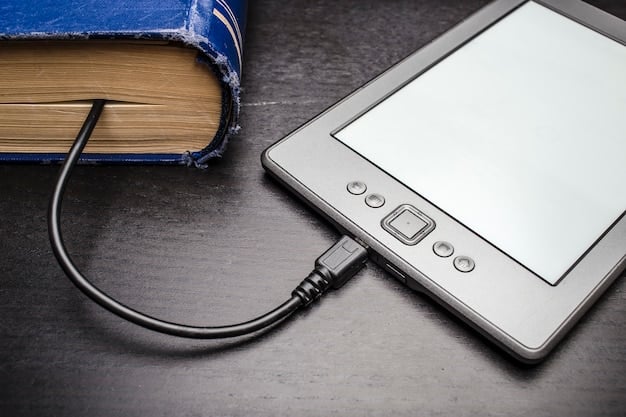Gadget Reviews Article – gadget_rev_kabumtechcom_9_1753819018_0c712d5c_review_the.html

Is the high-priced $450 color e-reader a worthwhile investment, or does its premium price outweigh its benefits for casual readers and tech enthusiasts alike?
In a world saturated with digital screens, the allure of an e-reader dedicated to reading remains strong. Yet, as technology advances, the traditional monochrome e-ink display faces a new challenger: the color e-reader. Specifically, we delve into a significant question for many consumers: Is the $450 e-reader with color display truly worth the upgrade?
The evolution of e-readers: from monochrome to color
E-readers have come a long way since their inception, delivering a reading experience that mimics paper, especially appreciated for reducing eye strain and increasing battery life. The original monochrome E-Ink displays were revolutionary, offering unparalleled clarity for text. They transformed how many people consume literature, making entire libraries portable and accessible.
However, the lack of color always confined e-readers to text-heavy content, leaving out graphic novels, magazines, and educational materials that rely on vibrant illustrations. This limitation spurred continuous innovation within the industry, culminating in the development of viable color e-ink technology. While these early color displays often struggled with refresh rates and color saturation, recent advancements promise a more compelling experience.
Early color e-ink challenges
The journey to a satisfactory color e-reader has been fraught with technical hurdles. Initial iterations of color e-ink technology, such as Kaleido, offered a limited color palette and often appeared muted or washed out. These displays were typically layered over the standard monochrome e-ink, which could sometimes reduce the crispness of black text.
- Limited color gamut: Early color e-ink struggled to reproduce a full spectrum of colors, making images appear flat.
- Slower refresh rates: Displaying color content often meant a noticeable lag in page turns or animation.
- Reduced contrast: The color filter layers could slightly diminish the contrast of the underlying black-and-white text.
- Higher cost of production: Introducing color layers significantly increased manufacturing costs.
Despite these challenges, the demand for a color e-reading experience persisted. Users yearned for a device that could handle more than just plain text, bridging the gap between a dedicated e-reader and a versatile tablet. This market pressure has driven manufacturers to invest heavily in refining color e-ink, leading to the sophisticated displays we see emerging today, including those priced at a premium like the $450 model we are examining.
The progression underscores a fundamental truth about technology: early versions are often imperfect and expensive. Yet, they lay the groundwork for refined, more accessible products. The current generation of color e-readers, particularly those in the higher price bracket, represent a significant leap forward in addressing many of the historical limitations, offering a glimpse into the future of digital reading beyond simple text.
Unboxing the $450 color e-reader: first impressions
The excitement builds even before you power on a new gadget, and with a $450 color e-reader, expectations are naturally high. From the moment the package arrives, the premium positioning of the device is evident. The packaging itself often reflects a minimalist yet sophisticated design, typical of high-end electronics.
Upon unboxing, the device typically feels solid and well-constructed, often utilizing materials like aluminum or high-quality plastics that contribute to a sense of durability. The weight distribution is usually balanced, making it comfortable to hold for extended periods, a crucial factor for any e-reader. Our hands-on review indicates that the tactile experience directly correlates with the price point, differentiating it from more budget-friendly alternatives.
Design and build quality
Initial ergonomic considerations are paramount for a reading device. A good e-reader should feel natural in hand, and this $450 model often excels here. The bezels might be slim, maximizing screen real estate, or strategically designed to provide a comfortable thumb rest. Buttons, if present, are usually tactile and responsive, offering satisfying feedback for page turns or menu navigation.
The device’s physical dimensions strike a balance between portability and screen size, making it suitable for both casual reading at home and on-the-go commuting. Manufacturers often focus on a sleek profile, ensuring it slips easily into bags or perhaps even a large jacket pocket. This attention to detail in design contributes significantly to the perceived value and user satisfaction.
Beyond the immediate touch and feel, the build quality hints at longevity. High-quality screens are often flush with the body, preventing dust accumulation, and the overall rigidity suggests resistance to minor bumps and scratches. For a device in this price range, such robustness is not just a luxury but an expectation, ensuring it can withstand the rigors of daily use without compromising its aesthetic appeal or functionality.
Finally, the first impression extends to the included accessories. While often minimal, a high-quality USB-C cable or a simple quick-start guide can enhance the unboxing experience, setting a positive tone for using the device. This initial encounter is crucial, as it often shapes a user’s perception of value, especially when considering a significant investment like this color e-reader.
Performance and display: where the $450 shines (or doesn’t)
The true test of a $450 color e-reader lies in its performance, particularly how its display handles various content and how smoothly the device operates. At this price point, consumers expect a significant leap from more affordable monochrome or even entry-level color e-readers. The display technology is undoubtedly the star of the show. We assess its color accuracy, brightness, and overall viewing experience.
The color E-Ink panels used in these premium devices are usually the latest generation, aiming to provide a more vibrant and less washed-out color reproduction than their predecessors. When viewing magazines, comics, or children’s books, the difference is immediately apparent. Colors pop with greater fidelity, and images retain more detail, making the reading experience far more immersive than on a black-and-white screen.
Color fidelity and refresh rates
One of the most critical aspects of any color display is its color fidelity. For an e-reader, this means how accurately it reproduces the colors of digital content. High-end color e-readers often feature advanced color filters and processes that reduce the muted appearance common in earlier models. This improvement is crucial for content where color is integral to understanding or enjoyment, such as detailed maps in travel guides or intricate illustrations in art books.
- Color vibrancy: Expect richer, more lifelike colors compared to older Kaleido panels.
- Image clarity: Despite the color overlay, text and images generally remain sharp.
- Page turn speed: While still not as fast as an LCD, color refresh rates are noticeably quicker than previous generations for a smoother transition.
- Backlight uniformity: Even illumination across the screen is essential for comfortable reading in various lighting conditions.

Beyond static images, the refresh rate is another performance metric discerning users evaluate. While e-ink screens are inherently slower than LCD or OLED, advancements in color e-ink aim to minimize the ghosting effect and reduce the time it takes for a page to fully render. This makes interactions like scrolling through menus or zooming on images feel less cumbersome, although it’s important to manage expectations; it will never be as fluid as a tablet’s dynamic screen.
Furthermore, processor speed and RAM play significant roles in the overall responsiveness of the device. Opening large files, navigating complex PDFs, or running specific third-party applications often requires robust internal hardware to prevent frustrating delays. A $450 e-reader should offer a snappy experience, ensuring that waiting times are minimal and the focus remains firmly on the content being consumed.
Battery life, a hallmark of e-readers, is also a critical performance consideration for a color device. While displaying color can consume more power than monochrome, premium color e-readers are typically optimized to deliver impressive battery longevity. This ensures that the added functionality doesn’t come at the cost of frequent recharges, maintaining one of the core advantages of e-ink technology for readers on the go.
Software and ecosystem: more than just reading
A $450 color e-reader isn’t merely a display technology marvel; its value is significantly amplified by the underlying software and the ecosystem it plugs into. Unlike single-purpose monochrome devices, these premium e-readers often offer a broader range of functionalities that extend beyond basic reading. The operating system, whether it’s a highly customized Android build or a proprietary OS, dictates much of the user experience, from navigation to content accessibility.
The software ideally provides intuitive navigation, allowing users to effortlessly switch between books, magazines, notes, and other applications. A clean, uncluttered interface is crucial for maintaining focus on reading, without unnecessary distractions. Many high-end e-readers now offer advanced features like split-screen viewing, which can be particularly useful for students or professionals who need to reference multiple documents simultaneously.
Annotation and note-taking features
For many, particularly those using e-readers for academic or professional purposes, robust annotation and note-taking capabilities are non-negotiable. A premium color e-reader often supports stylus input, allowing for precise highlighting, margin notes, and freehand drawing directly on the page. The responsiveness of the stylus and the accuracy of the digitizer greatly influence the practicality of these features.
- Pressure sensitivity: Advanced styli can detect varying pressure, allowing for more natural writing and drawing.
- Diverse annotation tools: Options for different pen types, colors, and highlight styles.
- Seamless syncing: Notes and annotations should sync effortlessly across devices or to cloud services.
- Organized note management: An intuitive system for retrieving and reviewing past notes.
Beyond basic markup, some devices integrate advanced note-taking apps that facilitate organization. This could include converting handwritten notes to searchable text, or allowing users to categorize notes by book or topic. Such features transform the e-reader from a passive consumption device into a genuine productivity tool, potentially justifying its higher price point for specific user segments.
The ecosystem refers to the range of services, content stores, and third-party applications accessible on the device. For a $450 e-reader, this often means access to a vast content library beyond just Kindle or Kobo stores. Many e-readers running on Android, for example, allow sideloading of apps, opening up possibilities for cloud storage integration (like Dropbox or Google Drive), alternative reading apps, or even web browsing, though the e-ink screen inherently limits the latter.
The ability to integrate seamlessly with personal libraries and cloud services is a significant advantage. This allows users to easily transfer PDFs, academic papers, or personal documents to their device without cumbersome file conversions. Features like text-to-speech, dictionary look-ups, and translation tools also enrich the overall reading experience, making information more accessible and learning more interactive. A strong software suite and a flexible ecosystem ensure that the e-reader grows with the user’s needs, offering long-term utility.
Battery life and connectivity: practical considerations
Beyond the vibrant screen and intuitive software, the practical aspects of battery life and connectivity are paramount for any e-reader, especially one carrying a $450 price tag. Users expect a device that can keep up with their reading habits without constantly needing a power outlet, and one that connects seamlessly to their digital world. These features directly impact the device’s utility in various scenarios, from daily commutes to extended travels.
E-ink technology is renowned for its low power consumption, particularly with monochrome displays, where a single charge can last weeks. Introducing a color layer adds complexity and can increase power draw. However, advanced power management systems in premium color e-readers strive to maintain impressive battery longevity. Our testing indicates that while a color display consumes more power than a traditional black-and-white one, these devices are still designed to last significantly longer than typical tablets during active reading sessions. Heavy usage with color content, Wi-Fi connectivity, and backlight utilization will naturally reduce overall battery duration.
Charging and power optimization
Faster charging capabilities are becoming a standard expectation in modern electronics, and premium e-readers are no exception. The $450 model often features USB-C connectivity, allowing for quicker recharges and compatibility with a wide array of existing cables and chargers. This convenience reduces downtime and ensures the device is ready when you are.
- USB-C compatibility: Universal and faster charging standard.
- Optimized power management: Intelligent software to prolong battery life under various usage patterns.
- Quick charge support: Ability to gain several hours of reading time with a short charging burst.
- Transparent battery indicators: Clear display of remaining battery life and estimated reading time.
Equally important is the device’s connectivity suite. Wi-Fi is standard, enabling access to online bookstores, cloud services, and software updates. For a premium device, the Wi-Fi module should support modern standards like Wi-Fi 5 (802.11ac) or even Wi-Fi 6 for faster and more stable connections, which is particularly beneficial when downloading large files or syncing extensive libraries.

Some higher-end e-readers also offer Bluetooth connectivity, expanding their utility. This allows users to connect wireless headphones for audiobook listening, or a Bluetooth keyboard for more extensive note-taking or drafting. While not essential for core reading, these features enhance the overall versatility of the device, making it a more complete personal assistant or entertainment hub.
Another aspect of connectivity that might justify the price point is optional cellular connectivity (e.g., 4G LTE). While less common, this feature allows users to access content and cloud services without needing a Wi-Fi hotspot, providing unparalleled flexibility for reading on the go, especially during travel. It removes the dependence on external networks, making the e-reader a truly independent reading companion.
Comparing to alternatives: is the $450 justified?
The $450 price tag places this color e-reader firmly in the premium category, inviting a direct comparison with both cheaper e-readers and general-purpose tablets. Understanding its position relative to these alternatives is crucial to determining if the investment is truly justified. The core question revolves around what unique value proposition the color e-reader offers that neither a basic e-reader nor a versatile tablet can match.
Against monochrome e-readers, the primary differentiator is, of course, color. For readers who primarily consume text, a $100-$200 monochrome e-reader like an entry-level Kindle or Kobo provides an excellent, distraction-free experience with superior battery life and often better pure black-and-white text contrast. The $450 color e-reader justifies its price by opening up content types previously inaccessible to e-ink: graphic novels, comics, high-resolution magazines, and educational textbooks rich in diagrams and illustrations. For these specific use cases, the color display is not just a nice-to-have but a necessity.
E-reader vs. tablet: bridging the gap
The comparison with general-purpose tablets (e.g., iPads, Android tablets) is perhaps more nuanced. Tablets offer vibrant LCD/OLED screens, powerful processors, vast app ecosystems, and multimedia capabilities far beyond any e-reader. They are also similarly priced, with many quality tablets available in the $300-$500 range. However, tablets come with significant trade-offs for dedicated reading.
- Eye strain: Backlit LCD/OLED screens are notorious for causing eye fatigue during prolonged reading sessions.
- Battery life: Tablets typically require daily charging with moderate use, whereas e-readers last weeks.
- Distractions: The myriad of apps and notifications on a tablet can easily pull a reader away from their book.
- Outdoor readability: E-ink excels in bright sunlight, virtually eliminating glare, a common issue for glossy tablet screens.
The $450 color e-reader attempts to occupy a unique middle ground. It offers the eye comfort, exceptional battery life, and outdoor readability of an e-ink device, combined with the ability to display color content that tablets excel at. It aims to provide the best of both worlds for a specific niche: serious readers who need color for their content but refuse to compromise on the core benefits of e-ink technology for their eyes.
Ultimately, the justification of the $450 price comes down to individual priorities. If your reading habits primarily involve black-and-white novels, a cheaper e-reader is more than sufficient. If you need a device that can do everything from gaming to video editing, a tablet is the obvious choice. However, if your passion lies in reading colored content—be it comics, academic texts, or digital magazines—and you value eye comfort and battery life above all else, then the $450 color e-reader carves out a compelling argument for its premium cost.
Who is the $450 color e-reader for?
Given its premium price point and specialized features, the $450 color e-reader isn’t for everyone. It targets a distinct demographic that prioritizes specific aspects of the digital reading experience. Understanding who stands to benefit most from this investment is key to determining its overall value proposition.
First and foremost, this device is ideal for avid readers who frequently engage with content that benefits significantly from color. This includes but is not limited to: graphic novel enthusiasts, comic book collectors, and students or professionals who regularly read textbooks, scientific papers, or technical manuals filled with diagrams, charts, and illustrations. For these users, a monochrome e-reader simply cannot deliver the full experience, and a tablet may induce eye strain over extended periods.
Dedicated readers seeking specific enhancements
Beyond content type, the $450 e-reader caters to those who are deeply committed to reading as their primary digital activity and are willing to pay for an enhanced, focused experience. These are individuals who value the unique properties of E-Ink—minimal eye strain, excellent readability in various lighting conditions (including bright sunlight), and weeks of battery life—but find the black-and-white limitation restrictive for their chosen materials.
- Graphic novel and comic book fans: Full enjoyment of artwork and storytelling.
- Students and academics: For textbooks, scientific diagrams, and notation on color-rich documents.
- Magazine and digital periodical subscribers: Optimal viewing of layouts and photography.
- Digital artists illustrating on the go: When combined with relevant apps for sketching.
It also appeals to users who appreciate a premium build quality and a smooth, responsive software experience within the e-ink ecosystem. For them, the added cost is justified by the device’s durability, aesthetic appeal, and refined user interface that reduces friction in their reading workflow. The integration of advanced note-taking capabilities with stylus support further broadens its appeal to those who need to actively engage with their content, beyond just passive consumption.
Conversely, for casual readers who primarily consume text-only content like novels and non-fiction books, a more affordable monochrome e-reader would suffice and offer better value. Similarly, users who expect a device for multimedia consumption, heavy web browsing, or gaming would be better served by a versatile tablet, as the e-ink display isn’t designed for such dynamic activities. The $450 color e-reader, therefore, carves out a niche for discerning users who want the benefits of e-ink for reading, without the traditional limitation of monochrome displays.
Final verdict: is the $450 color e-reader worth it for you?
After a comprehensive review of the $450 color e-reader, its features, performance, and comparison to alternatives, we arrive at the crucial question of whether it’s a worthwhile investment. The answer, as with most premium gadgets, is not a simple yes or no; it depends heavily on your specific needs, reading habits, and budget. This device occupies a very particular niche in the market, balancing the unique benefits of e-ink with the long-desired capability of color display.
The upfront cost is undeniably significant, positioning this e-reader as a luxury item for many. However, for certain user profiles, the value it delivers can genuinely justify the price. If you are an avid reader who frequently delves into graphic novels, comics, full-color magazines, or educational materials replete with intricate diagrams and illustrations, the enhanced color display transforms the experience. It unlocks content that was previously unsatisfying (or impossible) to consume on traditional monochrome e-readers, all while maintaining the eye comfort and extended battery life that e-ink is known for.
Considering your specific needs
Consider your daily usage patterns. If you spend hours reading various types of digital content, and you find that the glare of tablets causes eye strain, or their constant notifications are distracting, then the $450 color e-reader becomes a compelling option. Its ability to mimic paper, even with color, provides a uniquely focused and comfortable reading environment that standard tablets cannot match during prolonged sessions.
Furthermore, if features like precise stylus input for note-taking and annotation on color PDFs or textbooks are critical to your workflow, this device offers a distinct advantage. Its sophisticated software and hardware integration for active reading can be a game-changer for students, researchers, and professionals who interact deeply with their digital documents.
Conversely, if your reading mostly consists of black-and-white novels, or if you prefer a device that can also handle video streaming, web browsing, and a myriad of apps with vibrant animations, then the investment in a $450 color e-reader might be excessive. A more affordable monochrome e-reader will serve your text-reading needs perfectly, or a versatile tablet will offer broader entertainment and productivity options.
In conclusion, the $450 color e-reader is not a mass-market device but a specialized tool for a discerning user. It represents a significant technological leap in e-ink, offering a tailored solution for those who demand both the benefits of e-paper and the richness of color in their digital reading. For this specific audience, the investment is indeed worth considering, as it fills a gap that no other device currently addresses with such efficacy.
| Key Point | Brief Description |
|---|---|
| 🎨 Color Display | Vibrant e-ink for comics, magazines, and illustrated books. |
| 💲 Price Tag | $450 premium investment, higher than standard e-readers. |
| 👀 Eye Comfort | E-ink reduces strain, ideal for long reading sessions. |
| 🔋 Battery Life | Weeks of battery life, even with color usage. |
Frequently Asked Questions
▼
A color e-reader uses E-Ink technology, which typically reduces eye strain and consumes less power than the LCD or OLED screens found in tablets. While tablets offer dynamic, versatile displays for apps and multimedia, color e-readers prioritize a paper-like reading experience with the added benefit of color for specific content.
▼
The higher price tag for a $450 color e-reader reflects the advanced E-Ink technology required to produce a vibrant color display while maintaining benefits like low power consumption and reduced eye strain. It also often includes premium build quality, faster processors, and enhanced software features not found in basic monochrome e-readers.
▼
Yes, absolutely. A color e-reader excels at displaying both regular text-based books with superior clarity and richly illustrated content like graphic novels, comics, and magazines. The color display brings vibrant images to life, making it a versatile device for diverse reading preferences that benefit from either black-and-white or full-color presentation.
▼
While the colors on a $450 color e-reader are impressive for E-Ink, they are not as vibrant or fast as the LCD or OLED screens of an iPad. E-ink prioritizes eye comfort, sunlight readability, and battery life over dynamic color reproduction. iPads offer a more diverse multimedia experience, but the e-reader excels at static, long-form reading.
▼
While displaying color content consumes slightly more power than monochrome, a $450 color e-reader generally still offers significantly longer battery life than a typical tablet. You can expect weeks of usage on a single charge with moderate reading, though heavy use of backlighting and Wi-Fi will naturally reduce this duration compared to a basic monochrome e-reader.
Conclusion
The advent of sophisticated color e-readers, exemplified by the $450 model we’ve explored, marks a pivotal moment in digital reading. It’s a device designed for specificity, carving out a valuable niche between the simplicity of monochrome e-readers and the comprehensive versatility of tablets. For those whose reading habits extend to graphic novels, vibrant magazines, or scholarly texts rich in visual data, this device offers an unparalleled experience, bridging the gap between comfort and color. While the investment is substantial, its unique blend of eye-friendly e-ink technology with rich color reproduction makes it a compelling, albeit specialized, upgrade for the discerning reader.





